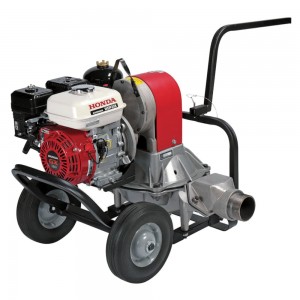 The Honda WDP30 diaphragm pump is designed to move water and debris under the harshest conditions, handling dry conditions, rocks and large solids with ease. Even with a design built for rough punishment, ensuring reliable service means knowing how to properly move and store it when it’s not in use.
The Honda WDP30 diaphragm pump is designed to move water and debris under the harshest conditions, handling dry conditions, rocks and large solids with ease. Even with a design built for rough punishment, ensuring reliable service means knowing how to properly move and store it when it’s not in use.
Preparing the Pump for Transport
When transporting the pump, it should be kept upright to prevent gas from spilling from the fuel tank. The engine should be allowed to cool completely to prevent the possibility of fire from contact between the muffler and cooling fins with flammable materials. Once the engine is cool, do the following:
Turn the ignition switch to “Off.”
Turn the fuel valve to “Off.”
Tilt the pump by placing the right wheel on a block. Any water still in the pump chamber should flow out of the discharge port.
Loading and Unloading
The pump can be rolled up ramps into the vehicle or hoisted into place using the lifting bracket at the top of the pump housing between the engine and grease fitting access plug.
The pump should be sitting level inside the vehicle, and it should be tied down with rope or straps running over the frame. Blocks should also be placed ahead and behind the wheels to keep the pump from rolling. Always keep straps and ropes away from the controls and carburetor to prevent the fuel system from opening and leaking.
Cleaning the Pump
Once the engine has cooled, wash it by hand. Never use a hose to rinse off the motor or pump: water can seep into the air cleaner which can cause damage to the engine.
Flush the pump chamber by lifting the right wheel onto a block so that the pump is sitting at an angle. Place the end of a garden hose in the suction side of the pump and turn on the water. Any debris should flow out of the discharge side.
Wash the pump, keeping water away from controls and crevices to prevent rust. Remove any standing water with a dry cloth, then start the engine to remove any remaining water through evaporation.
Once the engine has cooled, touch up any chipped paint and lightly oil any surfaces prone to rust. Lubricate the controls using a silicone-based spray lubricant.
Preparing the Fuel System for Storage
Fuel can degrade and oxidize in as little as a month. This degraded fuel is hard to ignite, making it difficult to start the motor while reducing power. In some cases, it can damage the fuel system. How degradation should be dealt with depends on how long the pump will be stored.
Short Term Storage (30-90 Days)
Fill the tank with fresh gas and add a fuel stabilizer. A full tank has less air inside, inhibiting oxidation and fuel deterioration. Run the engine for at least 10 minutes to ensure the fuel system is filled with stabilized gas.
With the engine still running, turn the fuel valve to the “off” position. The engine should shut down once the carburetor bowl is completely empty, no more than three minutes.
Long Term Storage (90 Days or Longer)
Place an approved gasoline container and a funnel below the carburetor. Remove the carburetor drain screw, located at an angle on the base of the carburetor, with a 10 mm wrench. Let any fuel inside drain into the container, then switch the fuel valve to “On.” This will drain any fuel remaining in the carburetor and fuel tank. Reinstall the drain screw and screw gasket.
Engine Oil
The engine oil should be changed before storing the pump, and the cylinder will need to be oiled to prevent seizing. To do this, remove the spark plug and pour a tablespoon (5-10 cc) of oil into the spark plug hole. Gently pull the starter grip a few times to spread the oil over the surface of the cylinder, then reinstall the plug.
Placing in Storage
If the pump is stored with gas in the fuel tank, it should be kept in a well ventilated area away from ignition sources like furnaces and clothes dryers to prevent the build-up and ignition of fuel vapors.
Ideally, the storage area should have low humidity to reduce rust and corrosion. Never cover the pump with plastic, as this can trap moisture, promoting rust.
To prevent fuel and oil leakage, make sure the fuel valve is set to “Off” and the pump is sitting level.
Removing from Storage
Perform the same pre-operation checks you would normally. If the fuel tank was drained before storage, be sure to add some fresh fuel. If the cylinder was lubricated before storage, it’s normal for the exhaust to be smoky at start up as this excess oil is burned off.
Where to Buy Honda Pump Parts
Need parts to keep your WDP30 up and running? Lost the tiny gasket that goes on the drain screw? www.hondalawnparts.com is a full line Honda OEM dealer with anything you need for Honda small engine equipment from parts to accessories and even specialty tools.
